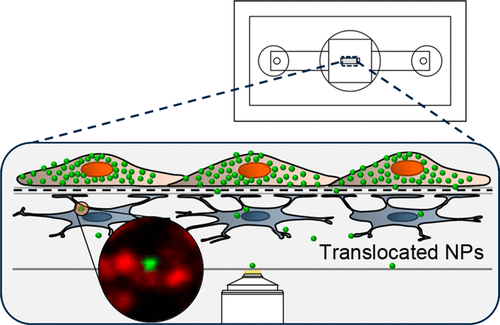Our official English website, www.x-mol.net, welcomes your
feedback! (Note: you will need to create a separate account there.)
Ultrathin Silicon Membranes for in Situ Optical Analysis of Nanoparticle Translocation across a Human Blood-Brain Barrier Model.
ACS Nano ( IF 15.8 ) Pub Date : 2020-01-14 , DOI: 10.1021/acsnano.9b08870 Diána Hudecz 1, 2 , Tejas Khire 3 , Hung Li Chung 3 , Laurent Adumeau 1 , Dale Glavin 3 , Emma Luke 3 , Morten S Nielsen 2, 4 , Kenneth A Dawson 1 , James L McGrath 3 , Yan Yan 1, 5
ACS Nano ( IF 15.8 ) Pub Date : 2020-01-14 , DOI: 10.1021/acsnano.9b08870 Diána Hudecz 1, 2 , Tejas Khire 3 , Hung Li Chung 3 , Laurent Adumeau 1 , Dale Glavin 3 , Emma Luke 3 , Morten S Nielsen 2, 4 , Kenneth A Dawson 1 , James L McGrath 3 , Yan Yan 1, 5
Affiliation

|
Here we present a blood-brain barrier (BBB) model that enables high-resolution imaging of nanoparticle (NP) interactions with endothelial cells and the capture of rare NP translocation events. The enabling technology is an ultrathin silicon nitride (SiN) membrane (0.5 μm pore size, 20% porosity, 400 nm thickness) integrated into a dual-chamber platform that facilitates imaging at low working distances (∼50 μm). The platform, the μSiM-BBB (microfluidic silicon membrane-BBB), features human brain endothelial cells and primary astrocytes grown on opposite sides of the membrane. The human brain endothelial cells form tight junctions on the ultrathin membranes and exhibit a significantly higher resistance to FITC-dextran diffusion than commercial membranes. The enhanced optical properties of the SiN membrane allow high-resolution live-cell imaging of three types of NPs, namely, 40 nm PS-COOH, 100 nm PS-COOH, and apolipoprotein E-conjugated 100 nm SiO2, interacting with the BBB. Despite the excellent barrier properties of the endothelial layer, we are able to document rare NP translocation events of NPs localized to lysosomal compartments of astrocytes on the "brain side" of the device. Although the translocation is always low, our data suggest that size and targeting ligand are important parameters for NP translocation across the BBB. As a platform that enables the detection of rare transmission across tight BBB layers, the μSiM-BBB is an important tool for the design of nanoparticle-based delivery of drugs to the central nervous system.
中文翻译:

用于对跨越人体血脑屏障模型的纳米颗粒易位进行原位光学分析的超薄硅膜。
在这里,我们提出了一种血脑屏障 (BBB) 模型,该模型能够对纳米颗粒 (NP) 与内皮细胞的相互作用进行高分辨率成像,并捕获罕见的 NP 易位事件。该支持技术是将超薄氮化硅 (SiN) 膜(0.5 μm 孔径、20% 孔隙率、400 nm 厚度)集成到双室平台中,有助于在短工作距离(∼50 μm)下成像。该平台名为μSiM-BBB(微流控硅膜-BBB),其特点是在膜的两侧生长人脑内皮细胞和原代星形胶质细胞。人脑内皮细胞在超薄膜上形成紧密连接,并且对 FITC-葡聚糖扩散的抵抗力明显高于商业膜。SiN 膜增强的光学特性允许对与 BBB 相互作用的三种类型的 NP(即 40 nm PS-COOH、100 nm PS-COOH 和载脂蛋白 E 共轭 100 nm SiO2)进行高分辨率活细胞成像。尽管内皮层具有出色的屏障特性,但我们仍能够记录到位于装置“大脑侧”星形胶质细胞溶酶体区室的 NP 的罕见 NP 易位事件。尽管易位始终较低,但我们的数据表明大小和靶向配体是 NP 跨 BBB 易位的重要参数。作为一个能够检测跨紧密 BBB 层的罕见传输的平台,μSiM-BBB 是设计基于纳米粒子的中枢神经系统药物输送的重要工具。
更新日期:2020-01-15
中文翻译:

用于对跨越人体血脑屏障模型的纳米颗粒易位进行原位光学分析的超薄硅膜。
在这里,我们提出了一种血脑屏障 (BBB) 模型,该模型能够对纳米颗粒 (NP) 与内皮细胞的相互作用进行高分辨率成像,并捕获罕见的 NP 易位事件。该支持技术是将超薄氮化硅 (SiN) 膜(0.5 μm 孔径、20% 孔隙率、400 nm 厚度)集成到双室平台中,有助于在短工作距离(∼50 μm)下成像。该平台名为μSiM-BBB(微流控硅膜-BBB),其特点是在膜的两侧生长人脑内皮细胞和原代星形胶质细胞。人脑内皮细胞在超薄膜上形成紧密连接,并且对 FITC-葡聚糖扩散的抵抗力明显高于商业膜。SiN 膜增强的光学特性允许对与 BBB 相互作用的三种类型的 NP(即 40 nm PS-COOH、100 nm PS-COOH 和载脂蛋白 E 共轭 100 nm SiO2)进行高分辨率活细胞成像。尽管内皮层具有出色的屏障特性,但我们仍能够记录到位于装置“大脑侧”星形胶质细胞溶酶体区室的 NP 的罕见 NP 易位事件。尽管易位始终较低,但我们的数据表明大小和靶向配体是 NP 跨 BBB 易位的重要参数。作为一个能够检测跨紧密 BBB 层的罕见传输的平台,μSiM-BBB 是设计基于纳米粒子的中枢神经系统药物输送的重要工具。











































 京公网安备 11010802027423号
京公网安备 11010802027423号